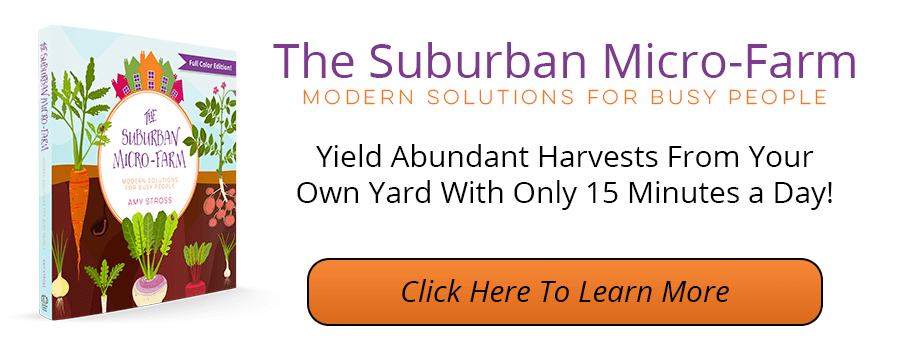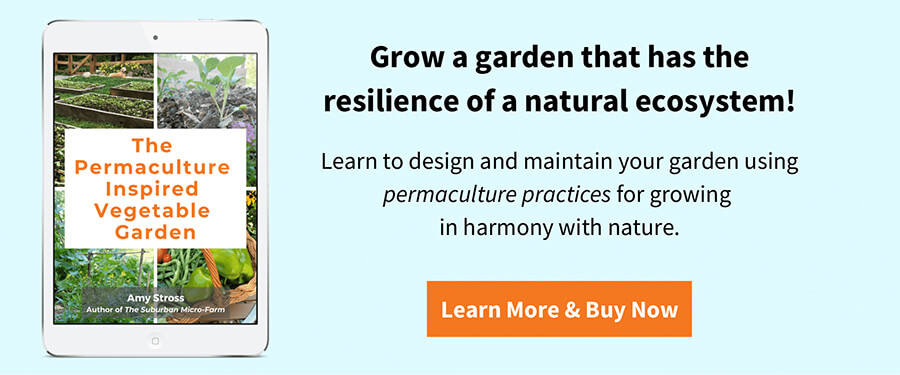Would you like to have a high-yielding fall vegetable garden? Follow these five easy steps for a smooth transition from summer to fall.

This page may contain affiliate links. Please read my disclosure for more info.
By late summer, many gardeners are weary and ready to throw in the trowel. However, the fall garden can be a wonderful change of pace. With cooler temperatures comes a unique set of low-maintenance crops such as beets, broccoli, carrots, lettuce, spinach, and more.
Timing the Fall Vegetable Garden
Giddy gardeners eagerly start preparing for the summer garden in early spring, when frost and—maybe, snow—are still the norm. Spring is when we shake off hibernation and pretend that warm days are just around the corner!
A similar anticipation welcomes us in the fall. A fall garden can be beautifully productive at a much slower pace. Even so, the trick is remembering that, like the summer garden, the fall garden needs to be started months before the cool weather comes.
For me in USDA zone 6, I prepare for the fall garden in July and August.
Would you like to have your fall planting dates automatically calculated for you? You’ll get my Seedstarting & Planting Worksheet (one of four bonus downloads) when you purchase my award-winning book, The Suburban Micro-Farm: Modern Solutions for Busy People!
Here are five easy steps for growing a low-maintenance and high-yielding fall garden.
Step 1: Make Space for Fall Garden Planting
When your summer garden is full and lush at the height of the season, it’s hard to think about fall. The last thing you want to do is rip out perfectly wonderful and productive, heat-loving plants to make room for cool-season crops. The good news is that if you plan well, you won’t have to!
Try the following suggestions.
Make Space #1: Plan Ahead
Intentionally leave a bed open for fall planting. I like to use my garlic bed for fall crops. After harvesting garlic in early summer, I sow buckwheat as a cover crop, and then cut it back when I’m ready to plant my fall garden.
Make Space #2: Plant Cold-Loving and Heat-Loving Vegetables Separately
This is an expert garden management tip. As you plant your spring and summer garden, group your cool-season crops (peas, leafy greens, root vegetables) together. Likewise, plant your warm-season crops together (fruiting vegetables) in their own beds. That way, no heat-loving, summer vegetables have to be sacrificed for your fall garden!
Make Space #3: Clear out Disease- or Pest-Infested Plant Matter
As soon as you notice an infestation in your garden, immediately remove infested plants. Throw away or burn all infested plant matter. Do not put it in the compost bin where the pest or disease could survive. In fact, this is essential to do before planting the fall garden because you don’t want to encourage pests to overwinter in the soil.
Remember, a few pests are okay. They attract beneficial insects to your garden! See: Guide to Preventing Pests in the Garden.
Make Space #4: Clear out Spent Plants
Harvest the seeds of any healthy crops or flowers that have gone to seed. Then chop and drop the plant matter directly onto the bed as mulch. Rather than pulling it out, cut the plant matter back and leave the decaying roots to feed the soil.

Before I cleared out spent plants and after.
If you miss any seeds while harvesting, then you’ve just reseeded the beds for next year with little effort!
- Saving Cilantro Seed
- Storing Seeds for Long-Term Seed Saving
- 6 Flowers to Grow in the Vegetable Garden
Make Space #5: Clear out Weeds
This is also a good time to clear out weeds, although keep in mind that many weeds are beneficial to the soil. (Learn more about some of my favorite weeds to welcome in the vegetable garden.) Rather than pulling the “good” weeds, cut them back and lay them on top of the soil or underneath the mulch to decompose as fertilizer.
Now you can breathe!
Step 2: Purchase Your Fall Garden Seeds and Plants
Assess your garden by asking, How much space is available for a fall garden? Decide what you’d like to plant, depending on what month it is and what your hardiness zone is. In order to estimate the number of seeds or plants that I need to purchase, I find it helpful to draw out the garden on a piece of paper.
Many popular fall crops such as broccoli, cabbage, lettuce, kale, and Swiss chard (I love this Celebration Swiss chard from Botanical Interests) can either be direct sown or transplanted as seedlings. If you’re short on time, go with seedlings for a quicker yield, which you can look for at your local garden store or farmers’ market.

I purchase seedlings if I’m short on time or didn’t get my fall crops started early enough.
Would you like to grow more food with less effort? Check out my mini guide, The Permaculture Inspired Vegetable Garden.
Other popular crops such as beets, carrots, peas, radish, and spinach are better sown directly in the garden.
Don’t forget to save room for your fall garlic! In my zone 6 garden, I plant garlic in October. I like to grow a hardneck variety called Chesnok Red.
Here are a few of my monthly planning and planting guides that provide more information about how I transition into fall garden season:
- July Garden Guide
- August Garden Guide
- September Garden Guide
- October Garden Guide
- Year-Round Gardening: It’s Easier Than You Think
Step 3: Amend the Soil
It’s always a good idea to amend the soil before planting. Adding organic matter improves soil fertility and feeds beneficial soil microbes that help plants to grow strong and healthy. Ideally you would amend the soil about two weeks before planting to let the soil assimilate the nutrients. However, don’t let this stop you from planting right away if you don’t have two weeks to spare!

I like to amend the soil before planting my fall garden.
Here are some of my favorite ways to amend soil:
- 7 Ways to Improve Soil Quality
- 9 Organic Amendments for Growing Vegetables
- Make a Worm Bin for Composting Food Scraps
Step 4: Sow Seeds or Transplant
When should you sow seeds and transplant seedlings? Get my fall planting guide which helps you identify your unique planting times for 17 popular crops.
Once you’ve prepared space for your fall garden, it’s time to sow seeds and transplant seedlings.
Be sure to water your seeds and transplants well, and keep the soil moist throughout the fall. In my geographical region, September is the driest month of the year. Cooler weather can mask the need to keep the garden watered.
Step 5: Protect Your Fall Garden to Extend the Harvest into Winter
Be prepared to protect your crops from frost so you can keep your fall garden going as long as possible. Depending on your climate, you could keep them going all winter long!
Fall weather can be variable from region to region, and unpredictable from year to year. In my region, frosts can hit as early as October, or as late as December.
Cold frames and row cover are two season extension techniques that are relatively inexpensive and easy to store in the off-season. Read more about how to protect your crops with a cold frame.

Use a cold frame to protect fall & spring crops.
Fall Garden Resources
Books
I recommend both of these books to learn more about extending your harvest throughout the year.
- Four-Season Harvest: Organic Vegetables from Your Home Garden All Year Long by Eliot Coleman. His books are a little older, but they’re really great and I’ve met him! 🙂
- The Year-Round Vegetable Gardener: How to Grow Your Own Food 365 Days a Year, No Matter Where You Live by Niki Jabbour
Seeds
Need seeds for your fall garden? Here are some of my favorites from Botanical Interests:
- Gourmet Blend beet
- Di Cicco broccoli
- Copenhagen Market cabbage
- Celebration Swiss chard
- Lacinato Dinosaur kale
- Parris Island romaine lettuce
- Easter Egg Blend radish
Fall Garden FAQs
#1: What vegetables can be planted in fall?
Cool season crops thrive in fall weather. Here are some of the most popular vegetables to plant in the fall garden: beets, broccoli, cabbage, carrots, kale, lettuce, peas, radish, spinach, and Swiss chard. And don’t forget to plant garlic in your fall garden!
#2: When should I plant my fall garden?
Many fall crops are planted in late July and early August, however, your specific planting dates will depend largely on where you live and your climate.
Check out my monthly garden guides (listed in Step 2 above) for fall garden planning and planting tips.
#3: How late can I plant in the fall?
This depends on where you live and your frost date. For example, brassicas such as broccoli, cauliflower, collard greens, and kale should be started indoors 15-18 weeks before your fall frost date, while radishes and spinach can be sown directly 5-7 weeks before your fall frost date.
See my fall planting guide, which covers planting times for 17 popular crops.
Have you tried growing a fall garden?
READ NEXT:
- How to Prepare for the Winter Garden
- Protect Cold Weather Crops with a Cold Frame
- Starting Seeds Indoors: A Step-by-Step Guide
>>> Get my free 19-page Guide to Organic Soil Amendments for more ideas:








Marietta says
Thanks so much! This is very good information, that I will use!!! 🙂
Heidi @ Pint Size Farm says
Wonderful! I need to get better about growing plants in the landscaping, but so much gets sun-burned here that it makes it hard to grow vegetables anywhere except protected locations!
Amy says
Sounds like we have opposite problems 🙂
Denise says
Amy, you are doing this wonderful work of researching and sharing good info with everyone freely. God bless you dear!